Auto Polish
Understanding the Essentials
Like so many areas of car care and auto detailing, auto polish is a topic filled with hundreds of choices and as many opinions! In an effort to help you become an informed consumer first, this page will help lay a foundation with which to help you make informed decisions.
From manufacturers of car polishes to car forums filled with wannabe experts, there is no shortage of opinions. The reality is that most people lack even enough experience to even ask the right questions. I find myself overwhelmed by mounds of choices and endless opinions myself; and this comes from someone with decades of professional experience.
Auto Polish Overload
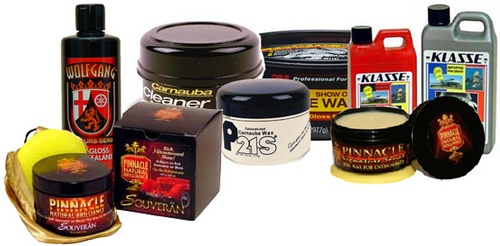
It is hard to come to a buying decision when there is no standardization of terms and labeling. What one person calls a polish, might be called a rubbing compound by the next person.
This industry is filed with so much hype and ignorance, it is very hard to formulate a working opinion or strategy moving forward.
I could present the following list of terms to a hundred people, and likely hear a hundred different opinions as to what these products are, what they are supposed to do, and how you are supposed to use them:
- Auto polish
- Rubbing compound
- Polishing compound
- Compounding Polish
To cut through the noise around car polishes and compounds, it helps to first understand the real game at play.
The truth?
Big manufacturers have one primary goal: sell you more products—whether you need them or not.
These all boil down to one thing: getting you to keep buying.
-
Endless Choices, On Purpose:
Companies flood the market with overlapping products, fancy packaging, and buzzwords—all designed to confuse you just enough to keep you guessing (and buying). -
A Cycle of Confusion:
The less you know, the easier it is to sell you things you don’t need. Most brands aren’t trying to make you an informed buyer—they’re trying to keep you dependent on marketing, not results.
Sound cynical? Maybe. But when labels mislead and product lines overlap for no good reason, it’s not hard to see the pattern.
But here’s the good news: You don’t need to fall into the trap. I’m here to give you real, honest guidance—no fluff, no gimmicks.
“Darren, just tell me what you’d do!”
Gladly. Let’s make this simple.
Best Auto Polish
My approach always begins with what I consider the simplest approach first!
This is also based on the understanding that you and your situation are unique and that due to the countless options in the form of an auto polish, compound or the like, you may need to experiment with more than just a single product.
The real point is that you must begin somewhere or you will never get anywhere.
So I will map out the choices I would use as to my starting point based on the description of the products that seem to align bet with you and your unique situation:
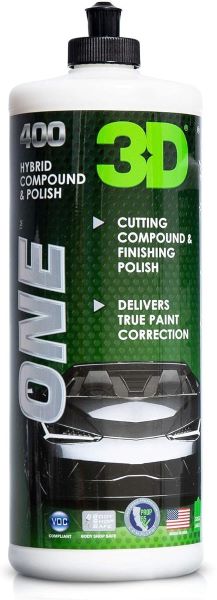
3D Compound and Polish on Amazon
Get professional results with less time and effort—3D One is the ultimate all-in-one solution for cutting and polishing in a single step. Whether you're a weekend warrior or a seasoned pro, this powerful formula brings tired paint back to life with clarity, gloss, and ease.
- ALL YOU NEED IS ONE: This advanced hybrid formula works as both a cutting compound and finishing polish, removing swirls, scratches, and oxidation in one step—perfect for restoring faded paint fast.
- TRUE PAINT CORRECTION: Built for detailers and enthusiasts alike, 3D One delivers real correction with flawless clarity and a deep, mirror-like shine—no dust, no compromise, on any color.
- VERSATILE APPLICATION: Use by hand for spot fixes or with a DA polisher for full panels. Whether it’s a daily driver or a show car, you’ll see and feel the difference.
- PRO GRADE QUALITY: Backed by over 25 years of experience and proudly made in the USA, 3D One is trusted by professionals around the world for its performance and reliability.
- NO GIMMICKS, JUST RESULTS: Forget the hassle of multi-step systems. 3D One simplifies your process, saving time and money while delivering long-lasting protection and a show-stopping shine—all from one bottle.
Darren's Tip: I will tell you that this product is in first position because it represents my first choice. I also believe that regardless of the color of your car, the manner in which you plan on polishing your car —by hand, with machine— this product will be the first and last compound/polish you will need for 99% of anyone reading this.
Of course this doesn't mean it will be the last product you ever buy —but wanting to tray a different product is different than needing to try a different product.
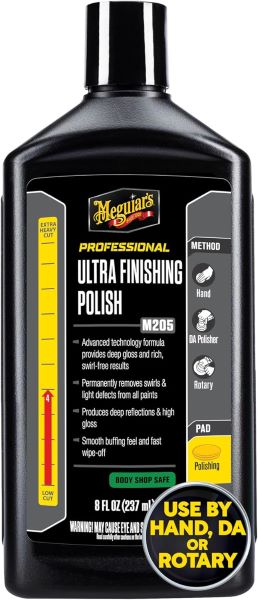
Meguiar's Auto Polish on Amazon
Achieve a flawless, high-gloss finish that turns heads and reflects your commitment to excellence. Meguiar’s M20508 Mirror Glaze Ultra Finishing Polish delivers professional-level results with ease, making it the ultimate choice for detailers and enthusiasts alike.
- SHOWROOM RESULTS: This advanced technology formula delivers a deep, dazzling gloss and swirl-free finish—giving your vehicle the luxury look it was made for. Expect flawless, mirror-like shine every time.
- SAY GOODBYE TO SWIRLS: Meguiar’s M20508 Mirror Glaze Ultra Finishing Polish eliminates swirls and light imperfections with precision. Designed for lasting clarity and brilliance, it leaves nothing behind but a smooth, refined surface.
- INCREDIBLE SHINE: Experience ultra-deep reflections and a brilliant gloss without the mess. This pro-grade polish brings out the best in your paintwork for a head-turning finish.
- EFFORTLESS APPLICATION: Whether you're using a rotary, DA polisher, or applying by hand, this polish goes on smoothly and wipes off with ease—making cleanup quick and simple.
- VERSATILE PERFORMANCE: Works beautifully with a variety of tools—hand, DA polisher, or rotary buffer. Ideal for following a cutting compound like Ultra Cut M105, and perfect before sealing in the shine with something like Pro Hybrid Ceramic Sealant M27.
Auto Polish: Working down the rabbit hole...
If you are really here in search of the best car wax, then you will need to follow that link. Since you came here using the search term of car or auto polish, I will limit the discussion to helping you not only understand more than when you came here, but help you in deciding the most appropriate car polish for you and your world.
Because this topic is filled with so much bad information and contradicting terminology, let's start with the very basic understanding of what a polish actually is, and what does this have to do with polishing your paint.
As stated within Wikipedia, polishing at its simplest definition "is the process of creating a smooth and shiny surface by rubbing it or using a chemical action." This is exactly where simple ends and confusion begins in the world of car polishing, car buffers, and specifically auto polishes.
Mechanical Polishing: (abrasive technology): This is where abrasives are used to literally abrade the surface to create a flatter, smoother, and more reflective surface.The flatter (this is referring to surface texture rather than lack of shine) the surface is, and the finer the actual scratches are, the more perfected and shinier the surface will appear. Mechanical polishing in a simple explanation is the process of using course abrasives that either diminish in their ability to abrade (referred to as diminishing abrasive technology in the world of automotive polishes) or by progressively polishing the surface with finer and finer abrasives. (this is where the multiple polishing steps and differing compounds and polishes are introduced) Under a microscope, your car paint will reveal two disturbing realities: the surface is literally made up of tiny hills and valleys (called surface texture or often referred to as an orange peel effect with the unaided eye), and endless scratches. Polishing with abrasives will diminish these hills and valleys by using abrasives that will literally allow you to scratch your way to perfection.
Chemical Polishing: Chemical polishing is the use of chemicals to "clean" and remove surface contaminants (not to be confused with the removal of embedded paint contaminates when using detailing clay) and/or surface oxidation. Many polishes in the world of car polishing rely on chemicals to perform the polishing. These types of polishes are the safest as they do not abrade the surface like mechanical polishing will do. But these types of polishes are severely limited in their ability to actually remove paint defects. Chemical polishes will enhance the appearance of your car paint by polishing the different types of defects, microscopic hills and valley's, but they are not going to be able to actually remove them.
Polishing a Car:
Hand polishing or machine polishing
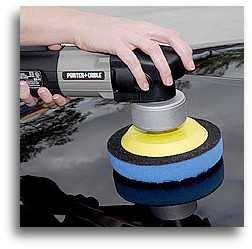
The next step in our learning curve when I am talking with people is usually about polishing a car by hand versus polishing a car by machine. If you thought there were mixed reviews and opinions before; this topic is even more divided!
So with that said, let me bullet point this for simplicity and clarity:
- Any auto polish you buy can be used by hand or machine regardless of what the label says. (like every other area in life, you simply respond to the moment. Kinda like saying you could never drive in the snow unless you have special snow tires. While this may not be particularly wise, you could still drive in the snow regardless. The conditions would quickly reveal both the abilities and the limitations of the moment.)
- Polishing your car by hand will appear to be the safer and easier method of using an auto polish, but your hand will never be capable of producing the results of a power buffer ( I get it; all the endless horror stories of damaged paint, burned edges, swirl marks, etc., etc.)
- Car buffers of today are far superior to anything we had in the past. They have been engineered to be so incredibly safe, that even a complete beginner can not only safely polish their cars paint, but perform at a professional level.
- I don't care who the person is; nobody will be able to replicate the power and consistency of a car polisher with their hand in the act of trying to polish a car.
Paint Correction and Blemish Removal
In order to actually remove, repair, or restore paint permanently, it will be required to use an auto polish or compound that contains actual abrasives.
There is no limit to the type of abrasives that a manufacturer might formulate into their compounds and polishes. But the fact remains that it must contain some form of abrasive(s) that will actually refine the paint by "scratching" the paint to higher and higher levels of perfection.
In simple terms, the more you polish, the more these abrasives can refine the paint (clear coat) by removing blemishes, scratches, swirl marks, wash scratch, etc.
The reality is that there are innumerable scratches present on your paint. These scratches cause the light to scatter and creates an unwanted appearance to your car paint.
Scratching your way to perfection by polishing your car will refine the paint surface more and more so that the reflective surface creates a more even surface that does not scatter the light as it is reflected, thus creating that show car shine.
Polishing with eventually create a uniform scratch pattern —a scratch pattern that will not look like scratches, but a highly refined surface.
- Makes the paint surface look flawless to your eye.
- Creates a uniform surface that reflects light (natural or artificial) evenly, thus creating that "wet-look" and true show-car shine.
- The more "flat" the surface is (I am referring to the physical quality of a flat surface —typically referred to as orange peel—with no texture at all, versus flat as in no shine), and the less scratches it has, the more "mirror like" the paint will look. So surface texture in many ways is as important as a scratch free surface.
Auto Polish with Cleaner
Many products will be labeled as a car polish and have no form of abrasives in it. These polishes have what are referred to as cleaners in them but can still be labeled as an auto polish. But the only form of "cleaners" are in the form of chemical cleaners, versus actual abrasives that true polishing requires. Any true auto polish will have at a minimum some type of abrasive particles that will literally scratch the surface of your car paint. This does not mean a manufacturer will not also add both abrasives and chemicals do perform the "cleaning" or polishing of your car, but to be a true "polish" in the area of car paint polishing, it will require abrasives.
And with that said, I have just demonstrated a very real problem within this industry of the misuse of terms and labeling. You came looking for an auto polish, and now I have deflected your attention onto cleaners that this industry will still label as an auto polish. (see how slippery this slope gets?)
The industry is filled with countless versions of auto polish and each manufacturer literally makes their own rules. Some companies are very clear in their labeling of auto polish and the type of polishing their particular car polish can perform. And then there are companies that simply suck!
The manner in which many car care companies label their products is poor at best, and downright misleading at worst. Many company's use ambiguous labeling and terminology to simply sell their particular product. Once again; companies are all competing for your attention and money.
Cleaner Waxes and Polishing By Hand
If you’re short on time or new to car care, cleaner waxes are the perfect place to start. Easy to use by hand, these products clean and enhance your paint without the risk of over-polishing—making them ideal for both beginners and seasoned detailers looking for a quick, effective solution.
- SAFE & SIMPLE: Designed with minimal abrasives and primarily chemical cleaners, these waxes are gentle on paint and safe for frequent use.
- ENHANCES, NOT CORRECTS: While they won’t deliver true paint correction, cleaner waxes effectively boost gloss and remove light surface grime for a refreshed finish.
- BEGINNER-FRIENDLY: Perfect for those new to detailing—simple, effective, and forgiving, with no need to worry about damaging your paint.
- FLEXIBLE APPLICATION: Use by hand or with a machine polisher—whichever suits your workflow and comfort level.
- START SMART: In detailing, the rule is always to begin with the least aggressive method. These cleaner waxes fit that philosophy and offer great results without overcomplicating the process.
Stop chasing endless reviews—just pick one and start. These cleaner waxes deliver results most drivers will be more than satisfied with.
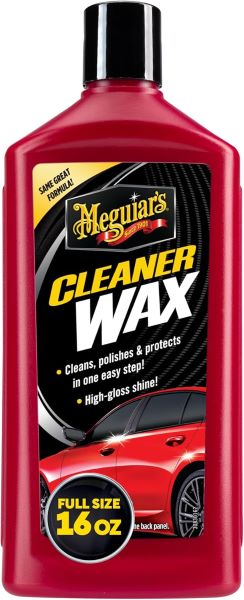
Meguia's Cleaner Wax on Amazon
Restore and protect your vehicle’s finish in one easy step with Meguiar’s Cleaner Wax. This all-in-one formula is designed to clean, polish, and protect—making it the perfect solution for a quick, high-impact shine.
- ONE-STEP CLEANER WAX: Cleans and waxes in a single step, removing surface contaminants while leaving behind a smooth, protected finish.
- HIGH GLOSS SHINE: Infused with rich conditioning oils that enhance depth and clarity, leaving your paint with a vibrant, high-gloss shine.
- SAFE FOR ALL GLOSSY PAINT: Effectively lifts blemishes and residues from all glossy surfaces, including clear coats and single-stage paint, without risking damage.
- EFFORTLESS TO USE: Goes on and wipes off more easily than traditional carnauba wax, saving you time while delivering professional results.
- FLEXIBLE APPLICATION: Apply by hand or use with a Dual Action Polisher like Meguiar’s MT300 for even faster, more consistent coverage.
Darren's Tip: While this product is both a polish and a wax, the point is that this product does not use abrasives to "refine" the paint surface. This product relies on chemical additives to perform what is labeled as "cleaning". Technically this is still a form of polishing, but this is what I call temporary results since you will not be making any significant change to the paint surface without abrasives.
The benefit of using this product compared to the polish from above is that you get to officially accomplish two tasks at the same time: "cleaning" the paint while adding wax to protect the paint. The major trade-off is that your results will be minimal when compared to using the dedicated polish from above.
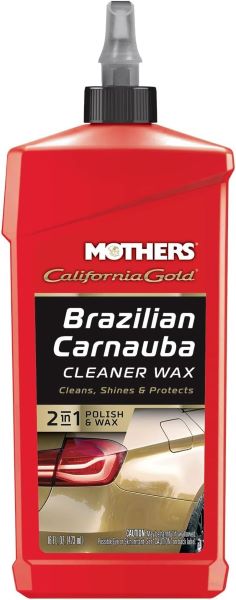
- The All-in-One cleaner wax I grew up using on my first cars.
- Still a popular product due to its ease of use and trusted brand name.
- For anyone looking to combine some cleaning ability with lasting protection.
- Contains heat resistant carnauba wax for a long-lasting shine.
- Top rated Amazon reviews.
Darren's Top Pick for Professional Grade Auto Polish
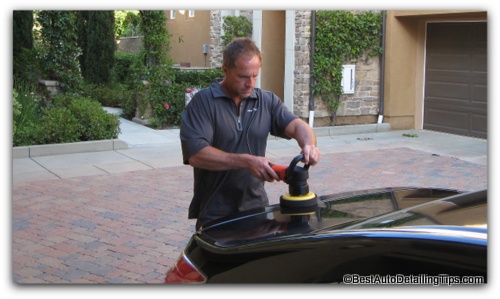
Just as an added note, there are many polishes out there that will perform at a professional level, the problem is that you will read one review after another, or listen to one expert after another and find yourself in one or both of the following:
- You hear/read opinion after opinion and you are frozen in anxiety, fear, and frustration not knowing which auto polish to choose, or.....
- You have listened to far too many "experts" and now you have a garage self full of car polishes and yet here you are, still looking for the next "best auto polish".
What You Need to Know to Get You Started
Due to all of the bad information floating around the many car forums and life in general, let me add some additional key points for clarification:
- The specific point you need to remember if you find yourself stuck, is to just start somewhere. You don't have to know everything. You just need to start, and any of the products on this page is an excellent starting point. But if you fail to start, you will fail to get anywhere!
- Any of these products can be used by hand or machine. If you are just starting out, the simple way will be to use one of these auto polishes by hand and then work from there.
- If you are just beginning and thinking of attempting to learn how to use a car polisher for the first time, I recommend starting out mild and working up from there. This link just below is the ideal place to start if you are thinking of learning how to use a car polisher.
- Home
- Car Polish
- This Page
|
|

